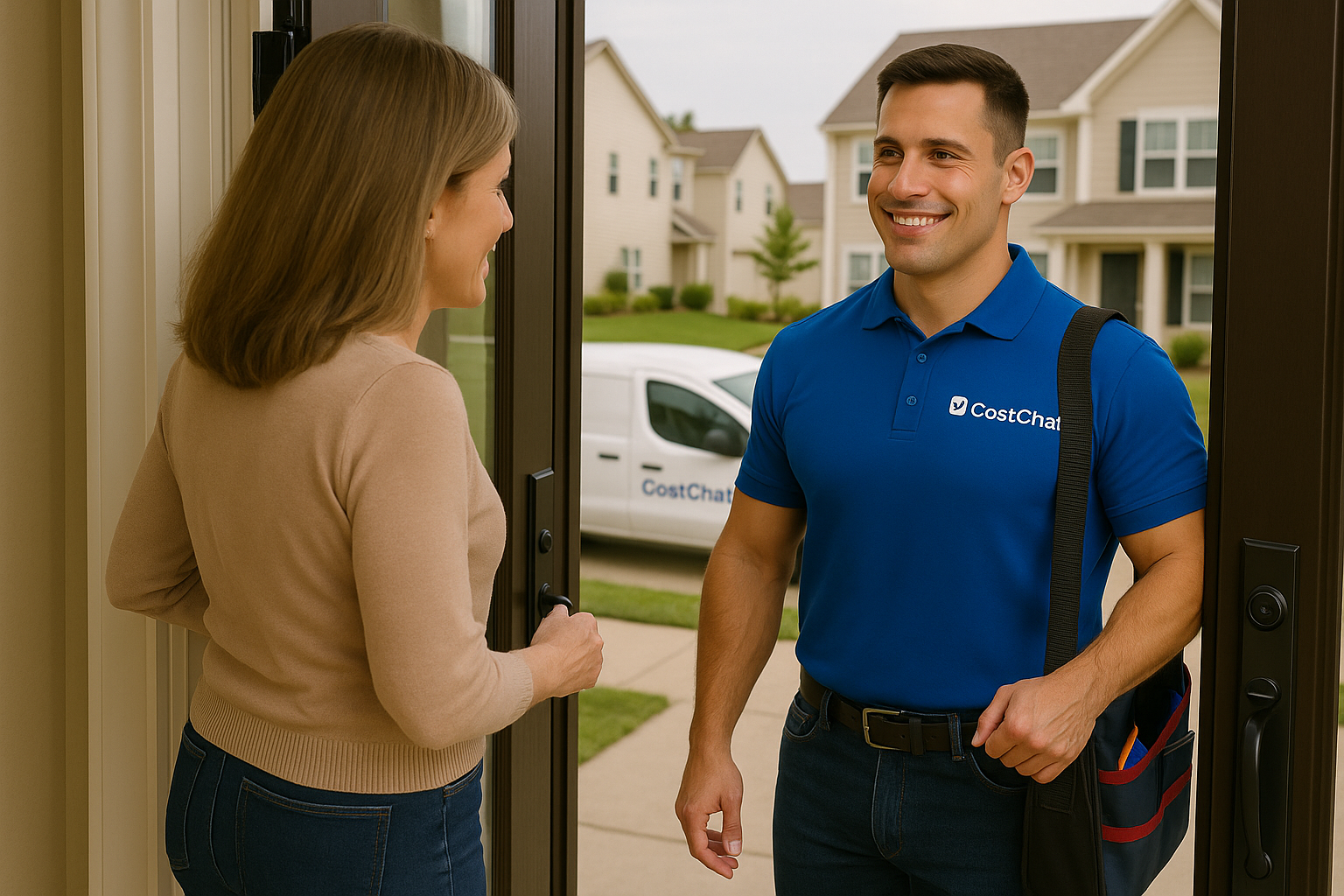
Find Verified Trenchless Sewer Repair Pros Serving Omaha, NE
How to Hire Top Rated Trenchless Sewer Repair Pros in Omaha, NE
Get a Free Online Estimate
Share your project details and receive a free online estimate from top-rated local pros. Not sure what it should cost? Check our Cost Guide.
Get EstimateCompare Local Quotes
View multiple free online quotes side by side. Use our Price Guide to understand labor rates, materials, and service fees before you hire.
Compare NowBook Best Top Rated Pros
Choose a licensed pro with confidence. Lock in your date after reviewing your free estimate and browsing our expert Cost Guide for peace of mind.
Book NowDid You Know?
74% ⚠️
of homeowners face surprise costs and delays — mostly from hiring unvetted pros. Don’t risk it. Hire trusted experts today.
Hire Top Rated & Verified ProsWork With Verified & Trusted Pros 🛡️
Save time, avoid costly mistakes, and experience reliable, top-quality service for every home project. Book now for priority scheduling and peace of mind.
Hire a Top Rated ProGet Instant Online Estimate of Trenchless Sewer Repair in
🔎 CostChat Online Cost Estimator
Describe your project and location to get an instant estimate.
Your Definitive Guide to Trenchless Sewer Repair in Omaha, NE
As a homeowner in Omaha, NE, you understand the importance of a reliable and efficient home infrastructure. Dealing with sewer line issues can be incredibly stressful, disrupting your daily life and potentially causing significant damage. This guide is designed to provide you with comprehensive, locally specific information on trenchless sewer repair, empowering you to make informed decisions. From understanding Omaha's unique challenges to navigating local regulations and finding the right professional, we're here to help you restore peace of mind and protect your home.
Table of Contents
- Omaha, NE's Unique Trenchless Sewer Repair Landscape
- Neighborhood Hotspots: Micro-Local Trenchless Sewer Repair Risks & Solutions
- Common Problems & Triggers for a Professional Trenchless Sewer Repair Call
- Navigating Trenchless Sewer Repair Regulations in Omaha, NE
- Maximize Your Savings: Trenchless Sewer Repair Rebates & Incentives in Omaha, NE
- Choosing Your Omaha, NE Trenchless Sewer Repair Solution
- Cost of Trenchless Sewer Repair in Omaha, NE
- Hiring Omaha, NE's Top-Rated Trenchless Sewer Repair Professional
- FAQs About Trenchless Sewer Repair in Omaha, NE
Omaha, NE's Unique Trenchless Sewer Repair Landscape: Why Local Expertise Matters
1.1 The Age & Character of Omaha, NE Homes: A Trenchless Sewer Repair-Related Time Capsule
Omaha's rich history is reflected in its diverse housing stock, with many homes built in the early to mid-20th century. This longevity means that a significant portion of our residences may have original plumbing infrastructure that is now nearing or exceeding its expected lifespan. Understanding the age and typical construction of homes in different Omaha neighborhoods is crucial when considering sewer line solutions.
- Early to Mid-20th Century Homes (Approx. 1920s-1960s): These homes, common in established areas like Dundee, Benson, and Elmwood Park, often feature Craftsman bungalows, Cape Cods, and early ranch styles. Their sewer lines may be made of materials like cast iron or galvanized steel. Cast iron is prone to cracking and root intrusion over time, while galvanized steel can corrode and become obstructed by mineral buildup. These issues can lead to frequent clogs and backups, making trenchless repair a viable, less disruptive alternative to full excavation.
- Mid to Late 20th Century Homes (Approx. 1960s-1980s): Ranch-style homes and split-levels became prevalent. Plumbing systems from this era might still use older PVC formulations or continue to use materials like cast iron, though copper became more common for water supply. The integrity of these older systems can still be compromised by age, ground shifts, or improper past repairs.
- Late 20th Century to Present Homes (Approx. 1980s-Present): Newer construction typically uses more durable materials like modern PVC or ABS for drain lines. However, even these can be susceptible to damage from extreme ground movement or installation errors. In slab foundation homes, common across many Omaha developments, pipe deterioration beneath the concrete can lead to costly slab leaks, where trenchless methods can offer a less invasive solution.
1.2 Omaha, NE's Environmental & Utility Factors & Climate Impact on Your Sewer Lines
Omaha's specific environmental conditions and the services provided by the Metropolitan Utilities District (M.U.D.) play a significant role in the longevity and performance of our sewer systems.
- Water Source & Quality: M.U.D. sources water primarily from the Missouri and Platte Rivers and the Dakota sandstone aquifer. While treated to meet high standards, Omaha’s water is moderately hard. This mineral content can contribute to scale buildup over time, not only in water supply lines but potentially within sewer lines as well, exacerbating blockages when combined with other debris.
- Climate Impact: Omaha experiences a humid continental climate with significant cold winters and freeze-thaw cycles. These cycles cause the ground to expand and contract, putting stress on underground pipes. This can lead to shifting, joint separation, and cracking, especially in older, more brittle pipes. Additionally, while Omaha generally receives moderate rainfall, occasional flooding from the Missouri and Platte Rivers can impact underground infrastructure, potentially overwhelming sewer systems or causing damage.
- Soil Conditions: Many Omaha neighborhoods have clay-based soil. Clay soil is known for its tendency to expand when wet and contract when dry. This constant shifting can exert pressure on sewer lines, contributing to cracks and joint failures over the years.
 Request a Quote
Request a QuoteNeighborhood Hotspots: Micro-Local Trenchless Sewer Repair Risks & Solutions
Omaha's diverse neighborhoods present unique challenges for underground infrastructure, including sewer lines. Understanding these micro-local risks can help you anticipate potential issues and choose the best repair method.
- Dundee & Benson: These historic neighborhoods feature many homes built in the early to mid-20th century. Expect older, potentially brittle cast iron sewer lines susceptible to cracks, root intrusion, and corrosion. Trenchless lining is an excellent solution here to preserve the mature landscaping and historic character of these areas while effectively restoring pipe integrity.
- West Omaha Subdivisions: Many of these areas, developed from the mid-to-late 20th century onwards, feature homes with slab foundations. This increases the risk of inaccessible pipe leaks or breaks beneath the concrete. If a sewer line issue is detected under the slab, trenchless pipe bursting or lining offers a way to replace or repair the line without extensive, disruptive demolition of concrete floors and foundations.
- South Omaha & Industrial Areas: Older infrastructure may be more prevalent, and the history of industrial activity in some parts of South Omaha could potentially impact soil composition or historical infrastructure decisions. These areas may also experience heavier usage demands on their sewer systems. Trenchless methods can provide a robust, long-lasting solution that minimizes disruption to busy streets and businesses.
- Aksarben & Newer Developments: While newer homes typically have modern PVC pipes, the sheer volume of development means that systems are working hard. Potential issues could stem from installation errors, soil settling, or cumulative wear and tear. Trenchless repair can still be beneficial for minor cracks or joint failures in these newer lines, preventing small problems from becoming major ones.
Common Problems & Triggers for a Professional Trenchless Sewer Repair Call
Recognizing the signs of a failing sewer line is the first step toward a timely and cost-effective repair. For many Omaha homeowners, these issues are often linked to the age of their home's plumbing and the local environment.
Common Warning Signs
- Persistent Clogs and Slow Drains: While a single clog might be minor, frequent or recurring blockages in multiple drains throughout your home are a strong indicator of a deeper issue within the main sewer line. This can be caused by buildup, tree root intrusion, or pipe collapse, common problems for pipes nearing their lifespan.
- Foul Odors: Persistent sewer gas smells emanating from drains or around your property are a clear sign of a break or leak in your sewer line, allowing gases to escape.
- Gurgling Sounds from Drains: Air trapped in the sewer line, often due to partial blockages or breaks, can cause gurgling sounds as water and air fight for space.
- Sewage Backups: This is one of the most serious signs, indicating a complete or near-complete blockage. Sewage backing up into toilets, showers, or floor drains signifies an urgent problem that requires immediate attention.
- Visible Damage to Yard: Unexplained wet spots, sinkholes, or an unusually lush patch of grass in your yard can indicate a leaking sewer line seeping wastewater into the soil.
Underlying Causes in Omaha
- Aging Pipes: Many Omaha homes have sewer lines made of materials like cast iron or clay, which have an average lifespan of 50-80 years. As these pipes age, they become brittle, corrode, crack, and are more susceptible to root intrusion.
- Tree Roots: Omaha's mature neighborhoods have established trees whose roots actively seek out water and nutrients, often infiltrating sewer lines through tiny cracks or faulty joints.
- Ground Movement: Omaha's clay soils and freeze-thaw cycles contribute to ground movement, which can stress and break underground pipes.
- Blockages: Incompatible items flushed down drains, grease buildup, or accumulated debris can cause blockages that put pressure on the line.
It's crucial to address these issues promptly. For more details on identifying potential problems, consult our guide on Warning Signs of Sewer Line Issues.
 Request a Quote
Request a QuoteNavigating Trenchless Sewer Repair Regulations: Permits, Code & Professional Licensing in Omaha, NE
Ensuring your trenchless sewer repair project complies with local regulations is vital for safety, quality, and legality. Here’s a breakdown of what Omaha homeowners need to know.
- Permitting Process: In Omaha, any significant plumbing work, including sewer line repair or replacement, requires a permit. The City of Omaha Planning Department is the issuing authority. Homeowners or their chosen contractor must obtain the necessary permits before work begins. This ensures the project meets safety and code requirements. You can find more information on their website: City of Omaha Planning Department.
- Governing Code: Omaha adheres to the Nebraska Plumbing Code, which is largely based on the International Plumbing Code (IPC) with local amendments. This code sets standards for materials, installation methods, vent systems, and waste disposal, ensuring public health and safety.
- Required Inspections: Typically, a sewer line replacement or repair project will require several inspections. These usually include:
- Underground Rough-in Inspection: Before the pipe is backfilled or covered, this inspection verifies proper pipe material, grade, and jointing.
- Final Inspection: After the system is installed and connected, this inspection ensures everything is functioning correctly, properly vented, and meets code.
- DIY vs. Professional Installation: While some minor plumbing tasks might be suitable for DIY, sewer line repair is complex and requires specialized equipment, knowledge of the plumbing code, and a deep understanding of underground infrastructure. Improper installation can lead to costly failures, environmental hazards, and health risks. We highly recommend professional installation. For guidance on what might be a DIY project, consider reading: When To Consider DIY.
- Contractor Licensing: In Nebraska, plumbing contractors must be licensed. The state authority responsible for this is the Nebraska Department of Health and Human Services, Division of Public Health. Licensed contractors must register with the state. Always verify a contractor's license before hiring. You can check licenses through the official Nebraska license lookup portal: Nebraska Professional Licensing.
Maximize Your Savings: Trenchless Sewer Repair Rebates & Incentives in Omaha, NE
Investing in your home's sewer system is significant, and Omaha homeowners can take advantage of potential savings through various programs.
- Metropolitan Utilities District (M.U.D.) Programs: M.U.D. offers water conservation programs and incentives aimed at reducing water usage and utility bills. While not always directly for sewer repair, efficient fixtures can reduce strain on the overall system. They have offered rebates for items like efficient toilets and water heaters. It's best to check their official website for the most current offerings: M.U.D. Conservation and Rebates.
- Federal Tax Credits: While specific sewer repair credits are rare, energy-efficient upgrades to your home, such as high-efficiency water heaters that might be part of a larger plumbing overhaul, can sometimes qualify for federal energy tax credits.
- Bonus Tip: Strategic Timing: Consider tackling sewer line upgrades or repairs when undertaking other major home renovations, such as landscaping or foundation work. This can sometimes allow for combined savings on labor and disruption.
For more ways to save on home services and upgrades, check out our Saving Tips guide.
 Request a Quote
Request a QuoteChoosing Your Omaha, NE Trenchless Sewer Repair Solution: Models, Sizing & Smart Features
Trenchless sewer repair offers advanced solutions tailored to minimize disruption. Here's a look at common methods and considerations for Omaha homes.
- Trenchless Pipe Lining (CIPP - Cured-In-Place Pipe):
- Pros: This is a highly effective method for repairing existing pipes without extensive digging. A resin-saturated liner is inserted into the damaged pipe and cured, creating a seamless, durable new pipe within the old one. It’s ideal for root intrusion, cracks, and corrosion. It preserves landscaping and existing structures.
- Cons: Not suitable for completely collapsed pipes. Requires access points at both ends. The pipe diameter is slightly reduced due to the liner thickness.
- Omaha Consideration: Excellent for historic neighborhoods with mature trees and delicate landscaping like Dundee and Benson, or for homes with slab foundations where minimizing excavation is key.
- Trenchless Pipe Bursting:
- Pros: This method replaces the old pipe entirely with a new, high-quality pipe (like HDPE). A bursting head is pulled through the old pipe, fracturing it outwards while simultaneously pulling the new pipe into place. It’s suitable for severely damaged or collapsed pipes and can sometimes allow for an upgrade in pipe size.
- Cons: Requires two larger access pits. Can be more expensive than lining. Potential for ground displacement.
- Omaha Consideration: A robust solution for completely failed sewer lines, especially in areas where the existing pipe material is severely compromised and needs a full replacement, such as older sections of South Omaha.
- Sewer Lateral Lining: This is a specific application of CIPP for the sewer line connecting a home to the main municipal sewer line, often under the street. It’s an efficient way to repair this critical connection point.
Key Installation Considerations for Omaha Homes
- Pipe Diameter and Flow: Ensure the chosen repair method maintains adequate pipe diameter to handle Omaha's typical household wastewater volume and prevent future flow issues.
- Soil Type: The clay-heavy soils in Omaha can exert significant pressure. The repaired or replaced pipe must be able to withstand these conditions.
- Climate Resilience: The new pipe material and installation methods should be chosen with Omaha's freeze-thaw cycles and potential for ground shifts in mind.
Cost of Trenchless Sewer Repair in Omaha, NE
The cost of trenchless sewer repair in Omaha, NE, can vary based on several factors, including the extent of the damage, the specific trenchless method used, accessibility, and the complexity of the job. Homeowners in Omaha can expect the following cost estimations:
- Trenchless Pipe Lining (CIPP): Typically ranges from $80 to $250 per linear foot. For a standard sewer line replacement in an Omaha home, this could mean a total cost anywhere from $4,000 to $15,000 or more, depending on the length of pipe needing repair and the number of access points required.
- Trenchless Pipe Bursting: This method is generally more expensive, ranging from $100 to $300 per linear foot. The total cost for a typical residential sewer line replacement using pipe bursting could fall between $5,000 to $20,000+. This higher cost reflects the need for new pipe material and the more involved process.
Factors Influencing Cost in Omaha:
- Pipe Material and Condition: Repairing or replacing aging cast iron or corroded galvanized steel pipes might incur different costs than working with older PVC. Severely collapsed pipes will naturally cost more to address.
- Length of Pipe: The linear footage requiring repair or replacement is a primary cost driver.
- Accessibility: While trenchless methods minimize excavation, access pits are still needed. The ease of creating these pits, considering landscaping or yard features, can influence labor costs.
- Neighborhood Location: While not a primary factor for trenchless methods, navigating older or more densely populated areas might require additional logistical considerations.
- Permits and Inspections: Costs associated with obtaining city permits and coordinating inspections add to the overall project expense.
It's essential to obtain detailed, itemized quotes from multiple licensed and insured Omaha-based plumbing contractors to get an accurate estimate for your specific situation.
 Request a Quote
Request a QuoteHiring Omaha, NE's Top-Rated Trenchless Sewer Repair Professional: Your Action Plan
Choosing the right professional for your trenchless sewer repair is critical for a successful, long-lasting solution. Here’s a step-by-step guide for Omaha homeowners:
- Verify Licensing and Insurance: Always ensure the contractor is licensed by the state of Nebraska and has up-to-date liability insurance and worker's compensation. This protects you from financial responsibility for accidents or faulty work. Use the Nebraska Professional Licensing portal to verify credentials.
- Seek Local Omaha Expertise: Look for contractors who specialize in trenchless technology and have a strong track record in the Omaha area. They will be familiar with local soil conditions, permitting processes, and common infrastructure challenges.
- Ask Hyper-Local Questions:
- "What experience do you have with cast iron sewer lines common in Omaha neighborhoods like Dundee?"
- "How do you handle Omaha’s freeze-thaw cycles and clay soil conditions during installation?"
- "Can you explain the specific trenchless method best suited for my home’s foundation type in my Omaha neighborhood?"
- "What is your process for obtaining permits from the City of Omaha Planning Department?"
- Get Multiple Detailed Quotes: Obtain at least three written estimates from different reputable companies. Ensure each quote clearly outlines the scope of work, materials used, warranty information, timeline, and total cost, breaking down labor and materials separately.
- Check Reviews and References: Look for online reviews on platforms like Google, Yelp, or the Better Business Bureau. Ask for references from recent clients in the Omaha area.
- Review the Contract Carefully: Before signing, ensure the contract includes all agreed-upon details, payment schedules, warranty information, and a clear description of the work.
Avoid common pitfalls by consulting our Mistakes to Avoid guide.
FAQs About Trenchless Sewer Repair in Omaha, NE
What is the typical lifespan of trenchless sewer repairs in Omaha, NE?
Trenchless sewer repairs, particularly cured-in-place pipe (CIPP) lining, are designed for longevity and typically have a lifespan of 50 years or more. Pipe bursting, which replaces the line with new HDPE pipe, can last 75 to 100 years. These estimates are based on quality materials and professional installation, factoring in Omaha's climate conditions.
How does Omaha's climate affect trenchless sewer repair choices?
Omaha's freeze-thaw cycles and clay soil can cause ground expansion and contraction, stressing underground pipes. Trenchless methods, especially lining, create a seamless, strong pipe that is more resilient to these movements than older, jointed pipes. When choosing materials for pipe bursting, selecting durable options like HDPE is essential to withstand these environmental pressures.
Do I need a permit for trenchless sewer repair in Omaha?
Yes, any significant plumbing work, including sewer line repair or replacement, typically requires a permit from the City of Omaha Planning Department. Your chosen contractor should handle the permit application process to ensure compliance with local building codes and safety standards.
Can trenchless sewer repair fix roots in my Omaha sewer line?
Absolutely. Trenchless pipe lining is particularly effective at sealing out tree roots. The seamless, cured-in-place pipe creates a barrier that roots cannot penetrate. This is a common solution for homeowners in Omaha’s established neighborhoods with mature trees.
What is the difference between pipe lining and pipe bursting for sewer repair?
Pipe lining (CIPP) repairs an existing pipe by inserting a new, seamless pipe within it, essentially creating a pipe within a pipe. It’s ideal for cracks, corrosion, and root intrusion. Pipe bursting replaces the old pipe entirely by fracturing it outward and pulling a new pipe into its place, suitable for collapsed or severely damaged lines and allowing for potential pipe size upgrades.
Addressing sewer line issues proactively can save you significant stress and expense down the line. Don't wait for a minor problem to become a major catastrophe.
Request a Quote Today